任务型教学法
任务型教学方法
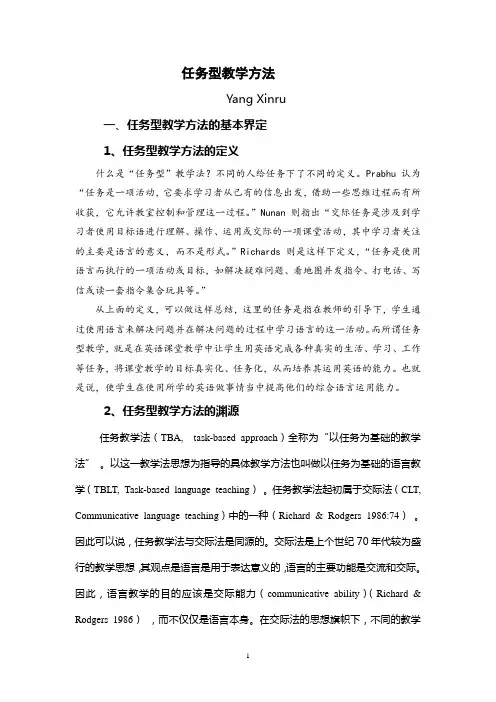
任务型教学方法Yang Xinru一、任务型教学方法的基本界定1、任务型教学方法的定义什么是“任务型”教学法?不同的人给任务下了不同的定义。
Prabhu 认为“任务是一项活动,它要求学习者从已有的信息出发,借助一些思维过程而有所收获,它允许教室控制和管理这一过程。
”Nunan则指出“交际任务是涉及到学习者使用目标语进行理解、操作、运用或交际的一项课堂活动,其中学习者关注的主要是语言的意义,而不是形式。
”Richards则是这样下定义,“任务是使用语言而执行的一项活动或目标,如解决疑难问题、看地图并发指令、打电话、写信或读一套指令集合玩具等。
”从上面的定义,可以做这样总结,这里的任务是指在教师的引导下,学生通过使用语言来解决问题并在解决问题的过程中学习语言的这一活动。
而所谓任务型教学,就是在英语课堂教学中让学生用英语完成各种真实的生活、学习、工作等任务,将课堂教学的目标真实化、任务化,从而培养其运用英语的能力。
也就是说,使学生在使用所学的英语做事情当中提高他们的综合语言运用能力。
2、任务型教学方法的渊源任务教学法(TBA, task-based approach)全称为“以任务为基础的教学法”。
以这一教学法思想为指导的具体教学方法也叫做以任务为基础的语言教学(TBLT, Task-based language teaching)。
任务教学法起初属于交际法(CLT, Communicative language teaching)中的一种(Richard & Rodgers 1986:74)。
因此可以说,任务教学法与交际法是同源的。
交际法是上个世纪70年代较为盛行的教学思想,其观点是语言是用于表达意义的,语言的主要功能是交流和交际。
因此,语言教学的目的应该是交际能力(communicative ability)(Richard & Rodgers 1986),而不仅仅是语言本身。
在交际法的思想旗帜下,不同的教学模式和大纲也相继被提出。
任务型教学法
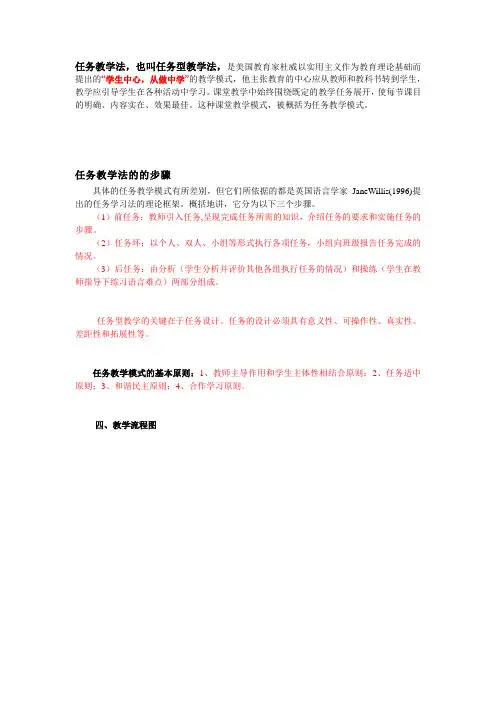
任务教学法,也叫任务型教学法,是美国教育家杜威以实用主义作为教育理论基础而提出的“学生中心,从做中学”的教学模式,他主张教育的中心应从教师和教科书转到学生,教学应引导学生在各种活动中学习。
课堂教学中始终围绕既定的教学任务展开,使每节课目的明确、内容实在、效果最佳。
这种课堂教学模式,被概括为任务教学模式。
任务教学法的的步骤具体的任务教学模式有所差别,但它们所依据的都是英国语言学家JaneWillis(1996)提出的任务学习法的理论框架。
概括地讲,它分为以下三个步骤。
(1)前任务:教师引入任务,呈现完成任务所需的知识,介绍任务的要求和实施任务的步骤。
(2)任务环:以个人、双人、小组等形式执行各项任务,小组向班级报告任务完成的情况。
(3)后任务:由分析(学生分析并评价其他各组执行任务的情况)和操练(学生在教师指导下练习语言难点)两部分组成。
任务型教学的关键在于任务设计。
任务的设计必须具有意义性、可操作性、真实性、差距性和拓展性等。
任务教学模式的基本原则:1、教师主导作用和学生主体性相结合原则;2、任务适中原则;3、和谐民主原则;4、合作学习原则。
四、教学流程图五、教学过程1.Warm-up and preview设计意图通过轻松的对话、具有竞争性的游戏复习已有知识,以最短的时间调动起学生脑海中的知识储备,并通过实际生活中存在的问题提出本节课的任务。
T: Good afternoon boys and girls. Today I’m very happy to talk about our favourite food with you. You can call me Ms Zhang. Nice to meet you.….T: First, let’s play a game-- “Magic Eyes”. Look at the screen, say the words as quickly as you can. Are you ready?Ss: Ready.T: Let’s go.简析大屏幕中依次闪出几组食物的图片,学生看到图片后快速说出英文单词,学生通过游戏的环节快速在脑海中积累本节课所需要的食物词汇,既能激发学生的兴趣,提高注意力,也为本课的学习做好词汇上的铺垫。
任务型教学法与“3P”教学法比较
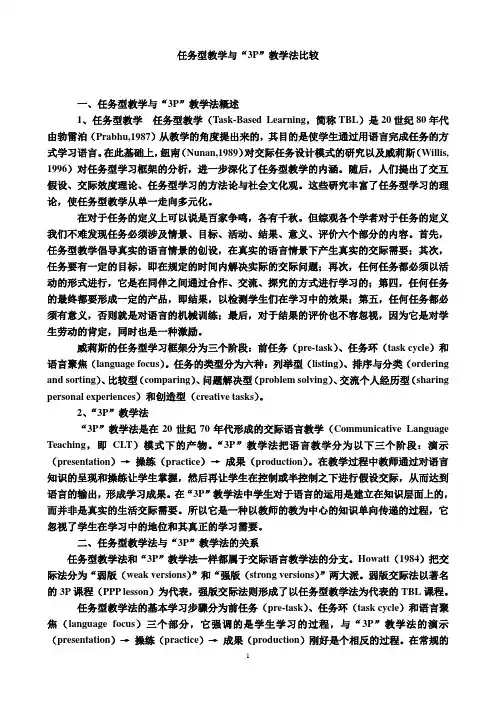
任务型教学与“3P”教学法比较一、任务型教学与“3P”教学法概述1、任务型教学任务型教学(Task-Based Learning,简称TBL)是20世纪80年代由勃雷泊(Prabhu,1987)从教学的角度提出来的,其目的是使学生通过用语言完成任务的方式学习语言。
在此基础上,纽南(Nunan,1989)对交际任务设计模式的研究以及威莉斯(Willis, 1996)对任务型学习框架的分析,进一步深化了任务型教学的内涵。
随后,人们提出了交互假设、交际效度理论、任务型学习的方法论与社会文化观。
这些研究丰富了任务型学习的理论,使任务型教学从单一走向多元化。
在对于任务的定义上可以说是百家争鸣,各有千秋。
但综观各个学者对于任务的定义我们不难发现任务必须涉及情景、目标、活动、结果、意义、评价六个部分的内容。
首先,任务型教学倡导真实的语言情景的创设,在真实的语言情景下产生真实的交际需要;其次,任务要有一定的目标,即在规定的时间内解决实际的交际问题;再次,任何任务都必须以活动的形式进行,它是在同伴之间通过合作、交流、探究的方式进行学习的;第四,任何任务的最终都要形成一定的产品,即结果,以检测学生们在学习中的效果;第五,任何任务都必须有意义,否则就是对语言的机械训练;最后,对于结果的评价也不容忽视,因为它是对学生劳动的肯定,同时也是一种激励。
威莉斯的任务型学习框架分为三个阶段:前任务(pre-task)、任务环(task cycle)和语言聚焦(language focus)。
任务的类型分为六种:列举型(listing)、排序与分类(ordering and sorting)、比较型(comparing)、问题解决型(problem solving)、交流个人经历型(sharing personal experiences)和创造型(creative tasks)。
2、“3P”教学法“3P”教学法是在20世纪70年代形成的交际语言教学(Communicative Language Teaching,即CLT)模式下的产物。
任务型教学法
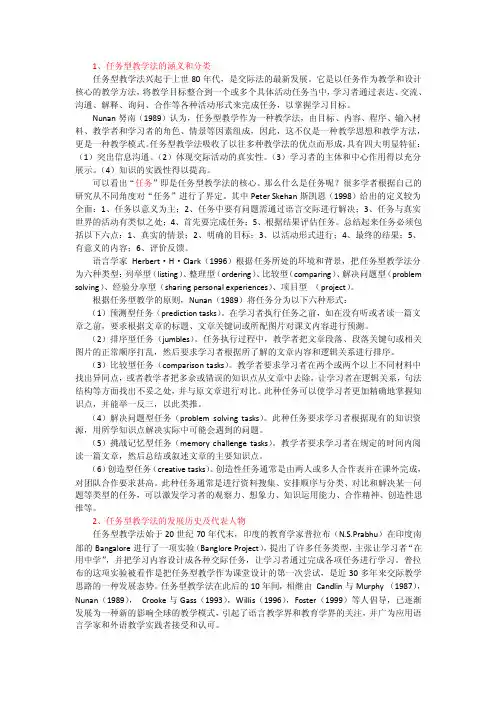
1、任务型教学法的涵义和分类任务型教学法兴起于上世80年代,是交际法的最新发展。
它是以任务作为教学和设计核心的教学方法,将教学目标整合到一个或多个具体活动任务当中,学习者通过表达、交流、沟通、解释、询问、合作等各种活动形式来完成任务,以掌握学习目标。
Nunan努南(1989)认为,任务型教学作为一种教学法,由目标、内容、程序、输入材料、教学者和学习者的角色、情景等因素组成,因此,这不仅是一种教学思想和教学方法,更是一种教学模式。
任务型教学法吸收了以往多种教学法的优点而形成,具有四大明显特征:(1)突出信息沟通。
(2)体现交际活动的真实性。
(3)学习者的主体和中心作用得以充分展示。
(4)知识的实践性得以提高。
可以看出“任务”即是任务型教学法的核心。
那么什么是任务呢?很多学者根据自己的研究从不同角度对“任务”进行了界定。
其中Peter Skehan斯凯恩(1998)给出的定义较为全面:1、任务以意义为主;2、任务中要有问题需通过语言交际进行解决;3、任务与真实世界的活动有类似之处;4、首先要完成任务;5、根据结果评估任务。
总结起来任务必须包括以下六点:1、真实的情景;2、明确的目标;3、以活动形式进行;4、最终的结果;5、有意义的内容;6、评价反馈。
语言学家Herbert·H·Clark(1996)根据任务所处的环境和背景,把任务型教学法分为六种类型:列举型(listing)、整理型(ordering)、比较型(comparing)、解决问题型(problem solving)、经验分享型(sharing personal experiences)、项目型(project)。
根据任务型教学的原则,Nunan(1989)将任务分为以下六种形式:(1)预测型任务(prediction tasks)。
在学习者执行任务之前,如在没有听或者读一篇文章之前,要求根据文章的标题、文章关键词或所配图片对课文内容进行预测。
任务型教学法
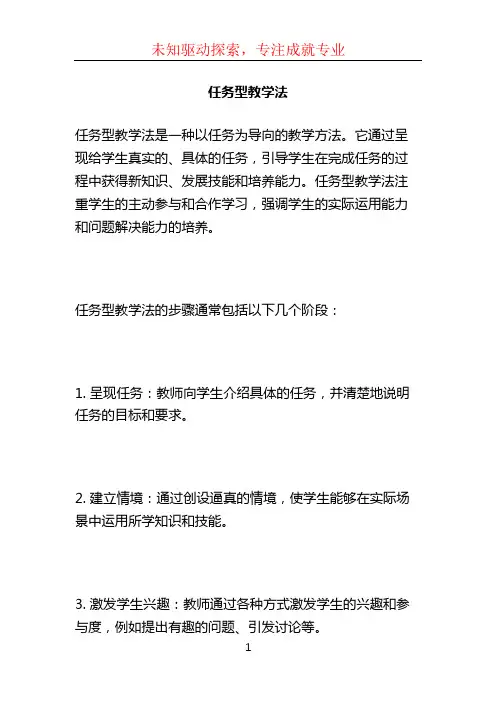
任务型教学法
任务型教学法是一种以任务为导向的教学方法。
它通过呈现给学生真实的、具体的任务,引导学生在完成任务的过程中获得新知识、发展技能和培养能力。
任务型教学法注重学生的主动参与和合作学习,强调学生的实际运用能力和问题解决能力的培养。
任务型教学法的步骤通常包括以下几个阶段:
1. 呈现任务:教师向学生介绍具体的任务,并清楚地说明任务的目标和要求。
2. 建立情境:通过创设逼真的情境,使学生能够在实际场景中运用所学知识和技能。
3. 激发学生兴趣:教师通过各种方式激发学生的兴趣和参与度,例如提出有趣的问题、引发讨论等。
4. 分组合作:将学生分成小组,让他们共同合作完成任务,促进学生之间的合作和交流。
5. 实施任务:学生在小组内按照所给的任务要求进行实际
操作,并解决遇到的问题。
6. 反馈评价:对学生的任务完成情况进行评价和反馈,帮
助他们发现问题和改进。
7. 总结归纳:通过对任务的总结归纳,帮助学生将所学知
识和技能进行整理和深化。
通过任务型教学法,学生能够在实践中学习和掌握知识,
培养解决问题的能力和综合运用能力,使学习更加有意义
和有效。
任务型教学以及它的步骤、优点、特点、意义
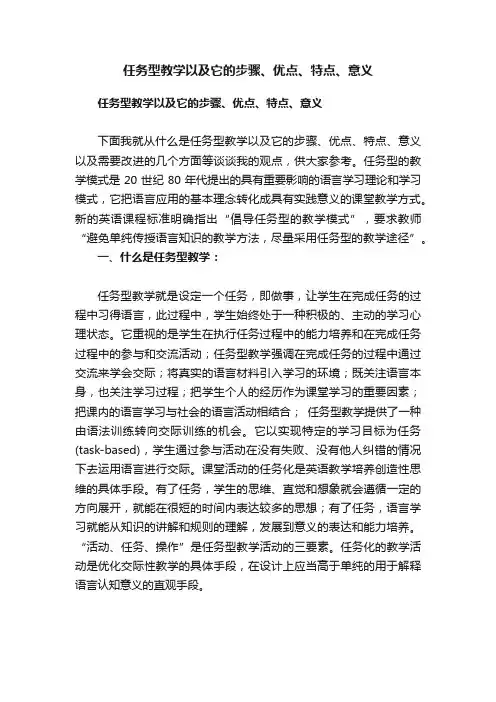
任务型教学以及它的步骤、优点、特点、意义任务型教学以及它的步骤、优点、特点、意义下面我就从什么是任务型教学以及它的步骤、优点、特点、意义以及需要改进的几个方面等谈谈我的观点,供大家参考。
任务型的教学模式是20世纪80年代提出的具有重要影响的语言学习理论和学习模式,它把语言应用的基本理念转化成具有实践意义的课堂教学方式。
新的英语课程标准明确指出“倡导任务型的教学模式”,要求教师“避免单纯传授语言知识的教学方法,尽量采用任务型的教学途径”。
一、什么是任务型教学:任务型教学就是设定一个任务,即做事,让学生在完成任务的过程中习得语言,此过程中,学生始终处于一种积极的、主动的学习心理状态。
它重视的是学生在执行任务过程中的能力培养和在完成任务过程中的参与和交流活动;任务型教学强调在完成任务的过程中通过交流来学会交际;将真实的语言材料引入学习的环境;既关注语言本身,也关注学习过程;把学生个人的经历作为课堂学习的重要因素;把课内的语言学习与社会的语言活动相结合;任务型教学提供了一种由语法训练转向交际训练的机会。
它以实现特定的学习目标为任务(task-based),学生通过参与活动在没有失败、没有他人纠错的情况下去运用语言进行交际。
课堂活动的任务化是英语教学培养创造性思维的具体手段。
有了任务,学生的思维、直觉和想象就会遵循一定的方向展开,就能在很短的时间内表达较多的思想;有了任务,语言学习就能从知识的讲解和规则的理解,发展到意义的表达和能力培养。
“活动、任务、操作”是任务型教学活动的三要素。
任务化的教学活动是优化交际性教学的具体手段,在设计上应当高于单纯的用于解释语言认知意义的直观手段。
二、任务型教学的意义:1、任务型教学中,教师则从学生“学”的角度来设计教学活动的,学生的活动具有明确的目标指向和具体的操作要求,在教学活动中,学生大脑始终处于一种激活状态,他们获得的不仅是语言知识,还获得了运用语言的能力。
随着学习任务的不断深化,学生语言能力的不断提高,整个语言学习的过程越趋自动化和自主化,学生了愈能创造性地表达自己的思想。
任务教学法
任务教学法任务教学法,也叫任务型教学法,是美国教育家杜威以实用主义作为教育理论基础而提出的“学生中心,从做中学”的教学模式,他主张教育的中心应从教师和教科书转到学生,教学应引导学生在各种活动中学习。
课堂教学中始终围绕既定的教学任务展开,使每节课目的明确、内容实在、效果最佳。
这种课堂教学模式,被概括为任务教学模式。
任务教学法是从20世纪80年代逐渐发展起来,广为应用语言学家和外语教学实践者认可和接受的一种外语教学方法,也是教育部制定的中学英语课程标准所推荐和提倡的外语教学法。
任务型教学法以任务组织教学,在任务的履行过程中,以参与、体验、互动、交流、合作的学习方式,充分发挥学习者自身的认知能力,调动他们已有的目的语资源,在实践中感知、认识、应用目的语,在“干”中学,“用”中学,体现了较为先进的教学理念,是一种值得推广的有效的外语教学方法。
任务教学法的内涵的探讨第一篇任务教学法中什么是任务?任务的本质是什么?任务是否等于普通的课堂练习?任务在课堂上怎样组织?任务的设计原则是什么?任务教学法的特点是什么?要使任务型教学法在中学外语课堂上得到充分和有效的应用,作为中学外语教学实践者,我们必须对这些问题有明确的认识和了解,因而也有必要对这些问题进行深入探讨。
一、什么是“任务”“任务”(task)一词进入应用语言学文献是在20世纪80年代初,它不仅仅作为一种课堂教学方法引起应用语言学家和外语教师的兴趣,同时,它也和大纲设计、教材发展有着紧密联系。
尽管“任务”在语言教学文献中是一个流行词,但使用者对这一术语的理解或解释却不尽相同。
如Breen认为,有助于达到语言学习整体目标的所有课堂活动都可看成是任务,包括简单短暂的语法练习以及复杂耗时的集体课堂活动。
[1]而Krahnke则将任务限定为为语言学习而进行的具有非教学目的的活动,[2]也就是说,Krahnke将课堂任务看成类似课堂之外(即真实生活中)的社会交际实践,具有交际目的而非教学目的的活动才能称之为任务。
任务型教学法_任务型教学法中“任务”的设计原则
任务型教学法_任务型教学法中“任务”的设计原则1 任务型教学法的定义、特点及作用任务型教学法是20世纪80年代以来在二语/外语教学界逐渐形成和发展起来的一种教学方法,是“交际法”(communicative approach)的发展。
任务型教学要求学习者完成具体的任务,如:讲述某个故事,叙述某一生活片段,提出解决某个问题的方法等。
它是一种“以完成具体的任务为学习动力和动机,以完成任务的过程为学习过程,以展示任务成果的方式来体现成就”(钟启泉,2001:260)的教学途径。
Nunan(2000)概括了任务型教学法的如下特点:(1)强调通过交流来学会用目的语交际。
(2)将真实的材料引入学习环境。
(3)学习者不仅注重语言的学习,而且关心学习过程本身。
(4)把学习者个人的生活经历作为课堂学习的重要资源。
(5)试图将课堂内的语言学习与课堂外的语言活动结合起来。
所以,任务型教学要求以学习者为中心,提倡真实的语言输入,鼓励学习者在做中学,即在运用语言的过程中学习语言。
它既强调语言形式的学习,又强调具体任务的完成。
由此看来,任务型教学法能够激发学习者的学习兴趣。
一个具体的问题或任务能使学习者产生明确的方向感,问题的解决或任务的完成又能使他们获得成就感。
这种方向感和成就感能够有效地提高和保持学习者学习语言的兴趣。
另一方面,学习者在完成任务的过程当中能够充分体验到如何搜集、处理各种信息;如何与同伴交流、合作;如何使用语言处理人际之间的信息差(information gap)、推理差(reasoning gap)、观点差(opinion gap) (Gray 1990:261)。
这些显然已经超出了语言学习本身,而将培养学习者的语言能力和培养他们的学习能力、交际能力、工作生活能力紧密地结合起来。
2 任务型教学法中的“任务”通常意义上的“任务”是指人们在日常生活中、工作中、游戏中所做的各种各样的事情。
Richards等人(2000:468)给语言教学中的“任务”下的定义是,为达到某一具体的学习目标而设计的活动。
任务型教学法在初中英语教学中的应用
任务型教学法在初中英语教学中的应用1. 引言1.1 任务型教学法的概念任务型教学法是一种以任务为中心的教学方法,着重于学生在实际情境中完成任务,通过任务实践来促进学生的语言学习。
任务型教学法注重学生的参与性和实践性,倡导学生在真实的语言环境中运用所学知识,培养学生的语言运用能力和解决问题的能力。
任务型教学法的核心理念是让学生通过完成各种任务来实现语言学习的目标,使学习过程更加具有目的性和实践性。
在任务型教学法中,任务被设计成学生能够理解和完成的实际活动,例如完成一份调查报告、制作一份海报等。
任务的完成需要学生综合运用所学语言知识和技能,培养学生的语言综合运用能力。
通过任务的完成,学生能够在实践中掌握语言知识,提高语言表达能力,培养解决问题的能力,从而达到语言学习的目的。
任务型教学法强调学生的参与性和主动性,使学习过程更加具有挑战性和激励性,激发学生学习的兴趣和动力。
Tasks foster interaction and meaningful communication.1.2 初中英语教学中存在的问题1. 学生缺乏学习动力:许多初中学生对英语学习缺乏兴趣和动力,导致学习效果不佳。
2. 传统教学模式单一:以传授知识和进行机械性记忆为主的传统教学模式无法激发学生的学习潜力。
3. 学生应试倾向严重:许多学生仅仅追求分数,而非真正掌握英语语言能力,导致学习质量低下。
4. 英语实际运用能力不足:学生在语言表达和交流能力方面存在欠缺,缺乏实际运用英语的机会和能力。
5. 学生缺乏合作意识和实践能力:传统教学方法未能培养学生的合作意识和实践能力,无法适应未来社会的需求。
2. 正文2.1 任务型教学法在初中英语教学中的具体应用方法1. 设计具体任务:教师可以根据教学内容和学生水平,设计具体的任务,如听力任务、口语任务、阅读任务和写作任务等。
任务要求有一定的难度和挑战性,能够激发学生的学习兴趣和主动性。
2. 分组合作:将学生分成小组进行任务完成,可以让学生通过合作互助的方式解决问题,提高学生的团队合作能力和沟通能力。
任务型教学法
任务型教学法什么是任务型教学法?任务型教学法是一种以任务为中心的教学方法。
它强调学习者的主动参与和实际应用能力的培养。
任务型教学法不仅注重知识的传授,更重视学习者在完成真实任务时的思维能力和合作能力的培养。
任务型教学法的特点1.学习者主动参与:任务型教学法鼓励学习者积极参与教学过程,通过实际任务的完成来促使学习者主动思考和探索。
2.真实感强:任务型教学法设计的任务通常与学习者现实生活中的问题和情境相关,使学习者能够感受到学习的实用性。
3.强调任务整合:任务型教学法将不同的学科知识、技能和能力有机地整合在一个任务中,培养学习者的综合素质。
4.合作学习:任务型教学法鼓励学习者通过小组合作完成任务,提高学习者的合作能力和团队意识。
5.自主学习:任务型教学法注重培养学习者的自主学习能力,通过任务设置,引导学习者自主发现和解决问题。
任务型教学法的优点1.激发学习兴趣:任务型教学法设计的任务通常与学习者实际生活中的问题和兴趣相关,能够激发学习者的学习兴趣。
2.提高学习效果:任务型教学法注重学习者的实际应用能力培养,能够提高学习者的学习效果。
3.培养合作精神:任务型教学法倡导学习者通过小组合作完成任务,能够培养学习者的合作精神和团队意识。
4.培养自主学习能力:任务型教学法鼓励学习者自主探究和解决问题,能够培养学习者的自主学习能力。
任务型教学法的步骤1.任务导入:教师通过引发学习者的兴趣,引入任务的背景和目的。
2.任务设计:教师设计与学习者现实生活相关的任务,确保任务具有真实感和可操作性。
3.任务执行:学习者根据任务要求,通过合作学习的方式完成任务,教师在过程中提供必要的指导和支持。
4.任务反思:学习者和教师对任务的完成进行反思和评价,总结经验教训,为下一阶段的学习做准备。
任务型教学法的应用场景任务型教学法适用于各个学科的教学,特别适用于语言、数学、科学等实践性较强的学科。
它在学校教育、培训机构、企事业单位等各个教育场景中都可以发挥作用。
- 1、下载文档前请自行甄别文档内容的完整性,平台不提供额外的编辑、内容补充、找答案等附加服务。
- 2、"仅部分预览"的文档,不可在线预览部分如存在完整性等问题,可反馈申请退款(可完整预览的文档不适用该条件!)。
- 3、如文档侵犯您的权益,请联系客服反馈,我们会尽快为您处理(人工客服工作时间:9:00-18:30)。
The Task-based InstructionThe Literature and History PressThe aims of this unit1. Definition of task from six different views2. Types of tasks3. Four components of a task4. Difference between exercises, exercise –task and task5. Difference between PPP and TBLT6. Components of TBLT framework7. Authentic sources of task8. learning principles in TB theory9.theoretical basis of TBI10 The criteria for good tasks11.types of tasks proposed by Wills12.learners’ roles13.teachers’s roles14 the principles for task design1. Definition of a task(1) A task is a piece of work undertaken for oneself or for others, freely or for some reward. Task is meant the hundred and one things people do in everyday life, at work, at play and in between—Long (1985:89)(2)Task is assumed to refer to a range of workplans. It has a particular objective, appropriate content, a specified working procedure, and arrange of outcomes for those who undertake the task. It has the overall purpose of facilitating language learning.--Breen (1987:23)(3) A task is an activity which requires learners to arrive at an outcome from given information through some process of thought and which allows teachers to control and regulate that process--Prabhu(1987:24)(4) A piece of classroom work, which involves learners in comprehending, manipulating (make good use of) producing or interacting in the target language while their attention is principally focused on meaning rather than form.--Nunan (1989:8)(5) Tasks are activities where the target language is used by the learner for a communicative purpose in order to achieve an outcome.--Willis (1996:23)(6) A task is essentially goal-oriented; it requires the group, or pair, to achieve an objective that is usually expressed by an observable result. Such as brief notes or lists, rearrangement of jumple items, a drawing, a spoken summary. This result should be attainable only by interaction between participants.--Ur(1996:123)Summary about a definition of a taskTask means the hundred and one things people do in a real life. It has a particular objective, appropriate content, a specified working procedures/process; based on a range of outcomes the learners undertake the task. It focused on meaning rather than form in a real context through comprehending, manipulating, producing, interacting, the process of thoughts in pairs or groups. The product can be observable in the oral way or written form.2. Categories of a task:real-life tasksIt includes painting a fence, dressing a child, filling out a form, buying a new shoes, making an airline reservation, borrowing a library book, taking a driving test, typing a letter, weighing a patient, sorting letters, taking a hotel reservation, writing a cheque, find a street destination, helping somebody across a road, brief notes or lists, rearrangement of jumbled items, a drawing, a spoken summary, and so on.3. Four components of a taskClark, Sxarino and Brownell (1994:40)•A purpose: Making sure the students have a reason for undertaking the task.•A context (situation): This can be real, simulated or imaginary, and involves sociolinguistic issues such as the location, the participants and their relationship, the time and other important factors.•A process: Asking students to use learning strategies such as problem-solving, reasoning, inquiring, conceptualizing and communicating.•A product: (outcome/result) there will be some form of outcome, either visible (a written plan, a play, a letter…) or invisible (enjoy a story/ reading for fun, listen to the radio, watch TV) learning about another country, etc)4. Differences between Exercises, Exercises task, and task •Exercises mean we may wish to focus their attention on individual aspects of language, such as vocabulary learning, grammar or individual skills.•Exercises-task: A kind of activity is very common in Communicative Language Teaching, comes halfway between task and exercises. This kind of activity consists of contextualized practice of language items (often a particular grammar point). For instance, it could be an activity that helps the students to master the present continuous tense by getting them to describe what is happening in a picture.The difference between tasks and practice•Tasks•Purpose: used to communicate, message delivering and problem-solving•Content for activity is a kind of contextualized, whole and authentic language materials•Practice•Purpose: to check mastery of language points, review ,consolidate and practice language forms •Content for activity is to practice isolated language points and skills•Forms for activity are used to give an analysis, reasoning, discussions, associations and the like •Results for activity are both language forms or non-language forms, eg. Tables and graphs. Every group can have a different result. It is meaning- focused•Forms for activity are to fill in the forms, rewrite, translate, check their answers by the students on their owns•Result for activity isform-oriented and consistency 一致性or only one answer is correct.• E.g., A dangerous moment•SA: Have you ever been in a situation where you felt your life is in danger? Describe thesituation to your partner. Tell him what happened. Give an account of how you felt when you were in danger and afterwards.•SB: listen to your partner’s narration about a dangerous moment in his/her life. Draw a picture to show what happened to your partner. Show him your picture when you have finished it.•E.g., Going shopping•Look at Mary’s shopping list. Then look at Susan’s list of items in Susan’s store.(1) Mary’s shopping list:Orange, eggs, flour, powdered milk (奶粉)biscuits, jam.(2) Susan’s store:bread, salt, apples, Coca Cola, tins of fish, flour, chocolate, sugar, biscuits, powdered milk, dried beans.( requirements) Work with a partner one person be Mary and the other be Susan. Make a conversation like this:•Mary: Good morning, do you have any flour?•Susan: Yes, I do.•Or•Mary: Good morning, do you have any jam?•Susan: No, I am sorry. I do not have any.5. Difference between PPP model and task-based instruction model •PPP—Presentation, Practice, Production•It means a typical PPP lesson would start by the teacher including a new language item in a context followed by some controlled practice, such as drilling, repetition, dialogue reading. Then students move on to produce the language in a more meaningful way such as a role-play, a drama, and interview. It contains five-step method:•◆Revision +P+P+P+ Consolidation=5 steps•Revision- presentation—drilling –practice—consolidation (五步教学法)5.1 A PPP cycle leads from accuracy to fluency•form focused activities•Context has to be invented•The process to be used to repeat manipulate and apply•Examples are made to illustrate a single language item•It is the teacher who pre-selects the language to be taught•A PPP cycle leads from accuracy to fluency•form-focused lesson5.2 TBI MODEL•learner rely on their own linguistic resources•Supplying a genuine need to communicate•Genuine purpose•A free exchange of ideas summarizing learner’s achievements•To consider appropriateness and accuracy of language form•Provide a context for grammar teaching and•The context is already established by the task itself•The process is used to encourage students to think and analyze•Students are free to ask about something they notice•TBLT cycle leads from fluency to accuracy•Four skills oriented lessons•Warming up –pre—while—post—project•Preparation (revision, prediction, enquiring启发, brainstorm,warming up) •presentation (observing, discovering, receiving, acquiring学得and learning)—practice (mechanical and meaningful真实性交际活动)•production (target tasks真实性任务and project)•progress (consolidation,summary and checking)•5P MODEL•Teaching principles for implementation based on task.1. Meaning and form 形式与意义结合2. Recycling (在某时间段内或材料内,不断复现知识)循环性原则3. Learning by doing (active learning, accommodation some experience, individual learning, reproduction 模仿to creation)做中学原则4. Scaffolding (help, aid)扶助性原则学习效果=50%学习策略+40%努力+10%智商•学习策略 learning strategies•1. cognitive learning strategies( attention, transfer, reasoning, induction , comparison, association 联想)2. Monitoring learning 调控(planning, reflection, assessment , adjustment for plan)3. Communicative learning (自我表白,交笔友,写日记,写信,发邮件)4. Resource learning strategies (认识资源,选择资源,订阅优质资源,查询资源,加工资源,创造性活动),TBI is based on skill-oriented lesson•Eg. Reading teaching:•Teaching reading focuses on developing reading skills. In practice, another 3-stage model is advised and adopted in a reading lesson: pre-reading, while-reading, post-reading. This model is also applied in listening lessons.•. Pre-stage involves preparation work such as setting the scene, warm-up, key information provided or key words.•. While- stage involves activities or tasks students must perform while they are reading or listening•. Post -stage provides a chance for students to obtain feedback on performance at the while-stage. It also involves some follow-up activities, re lated to the learner’s own life and use of the language spontaneously.6. Components of TBL Framework•.①Pre-task: introduction to topic and task•Teacher explores the topic with the class, highlights useful words and phrases, help students understand task instructions and prepare. Students may hear a recording of others by doing a similar task.•.②Task, Planning, Report•Task: Students do the task, in pairs or groups. Teacher monitors from a distance •Planning: Students prepare to report to the whole class (orally or in writing) how they did the task, what they decided or discovered.•Report: some groups present their reports to the class, or exchange written reports, and compare results.•.③Language focus: Analysis and practice•Analysis: students examine and discuss specific features of the text or transcript of the recording •Practice: Teacher conducts practice of new words•Phrases: patterns occurring in the data, either during or after the analysis.7. Types of tasksPica, Kanagy, and Falodum (1993) , Wills (1996) classify tasks according to the type of interaction that occurs in task accomplishment and give the following class of :•1. Jigsaw tasks (拼图任务):The aim is for students to make a whole from different parts. Individual has different source.•Students read/ listen to / view their station, and report to the others what it contains. •Discuss how to make them together.•Product is reassembled text written by the group or presented orally•学习者相互交流各自掌握的不同信息,并在此基础上组合成某种完整的信息(信件、表格)•2. Information-gap tasks(信息差):Comparison tasks•To ask students to compare two similar or different texts in a different fact or attitude to find points in common.•Ask stu dents to read about each other’s experience of school to find or list points they have in common. It is based on the same incident/ different description.•Ask students to list the points in common or spot the difference between the different newspapers/broadcast, story.•一个学生(组)掌握一部分信息,另一个(组)学生掌握另外一部分信息。
